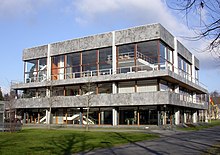Paul Baumgarten (architect, 1900)
Paul Baumgarten (full name Paul Gotthilf Reinhold Baumgarten ; * May 5, 1900 in Tilsit ; † October 8, 1984 in Berlin ) was a German architect and professor at the Berlin University of the Arts (HdK).
Life
Baumgarten studied architecture from 1919 to 1924 at the Technical University of Danzig , then at the Technical University of Berlin , and then worked in the architectural office of Mebes & Emmerich in Berlin. From 1928 increasingly busy with their own jobs, he could in 1932 independently make. From 1934, as head of the construction department of Müllabfuhr AG, he built, among other things, the garbage loading station in Berlin-Charlottenburg, one of the convincing examples of New Building during National Socialism . From 1937 to 1945 he was head of the building construction office of the construction company Philipp Holzmann AG , and from 1942 he was also a university professor at the HdK Berlin.
With the construction of the HdK concert hall in 1953, where he was appointed professor in 1952, and with the reconstruction of the Reichstag, he became known in post-war Germany. His contribution to Interbau 1957, the so-called Eternit-Haus , also attracted attention . On the other hand, his further plans in residential construction, especially in settlement construction, have received less attention.
He is not related to the architect Paul Otto August Baumgarten, who was born in 1873 .
Buildings (incomplete selection)

- 1932: House Czesalsky in Berlin-Tegel , Eisenhammerweg 8
- 1933–1934: Seemann house in Berlin-Hermsdorf , Hermsdorfer Damm 155
- 1934–1936: Garbage loading station in Berlin-Charlottenburg, Helmholtzstrasse
- 1936: Housing complex Halenseestrasse, Bornimer Strasse, Kurfürstendamm 124A
- 1937–1938: Housing complex Düsseldorfer Strasse / Brandenburgische Strasse in Berlin-Wilmersdorf
- 1939–1941: Reich youth leadership in Berlin- Westend (with Paul Emmerich )
- 1938–1941: Office building Heerstraße 12–16 (then Kaiserdamm) for the Reich youth leadership of the HJ and the Berlin branch of Philipp Holzmann AG in Berlin-Westend (with Paul Emmerich)
- 1939: Huebner House in Berlin-Charlottenburg, Badenallee 29
- 1952–1953: HdK concert hall and studio stage in Berlin
- 1955–1956: Two-family house in Berlin-Grunewald, Wissmannstrasse 12A
- 1956–1958: Boris Blacher house in Berlin-Zehlendorf, Kaunstraße 6
- 1956–1958: Canteen for the Eternit plant in Berlin-Rudow
- 1957: Eternit house at the Interbau in Berlin
- 1957–1959: Protestant church on Lietzensee in Berlin-Charlottenburg, Herbartstrasse 5
- 1958: Wellekamp housing estate in Wolfsburg- Hohenstein
- 1958–1959: Clubhouse of the LTTC Rot-Weiß in Berlin-Grunewald
- 1958–1959: "Ruhrkohle-Haus" in Berlin-Charlottenburg, Bismarckstrasse 107
- 1961–1973: Reconstruction of the Reichstag building in Berlin-Tiergarten
- 1962–1964: Wipperstrasse residential complex in Wolfsburg- Teichbreite
- 1965: Official building of the Federal Constitutional Court in Karlsruhe
- around 1965: Day care center for the elderly in Wolfsburg-Hohenstein
- 1965–1967: Stepped high-rise in Wolfsburg-Detmerode
- 1966–1968: Copper cafeteria and lecture hall building of the Eberhard Karls University of Tübingen
- Conversion of the Hotel am Zoo in Berlin
literature
- Günther Kühne u. a: Paul Baumgarten. Buildings and projects 1924–1981. (Exhibition catalog of the Academy of Arts) Berlin 1988.
- Annette Menting: Paul Baumgarten. Creating from the character of time. (= The buildings and art monuments of Berlin.) Gebr. Mann, Berlin 1998.
- Falk Jaeger, Ed .: Transparency and Dignity – The Federal Constitutional Court and its Architecture , JOVIS Verlag Berlin, 2014, ISBN 978-3-86859-286-3
Individual evidence
- ↑ Entry in the list of monuments in Berlin
- ↑ Entry in the list of monuments in Berlin
- ↑ Entry in the list of monuments in Berlin
- ↑ Entry in the list of monuments in Berlin
- ↑ Entry in the list of monuments in Berlin
- ↑ Entry in the list of monuments in Berlin
- ↑ Entry in the list of monuments in Berlin
- ↑ Entry in the list of monuments in Berlin
- ↑ Entry in the list of monuments in Berlin
- ↑ Entry in the list of monuments in Berlin
- ↑ Entry in the list of monuments in Berlin
- ↑ Entry in the list of monuments in Berlin
- ↑ Entry in the list of monuments in Berlin
- ^ Nicole Froberg, Ulrich Knufinke, Susanne Kreykenboom: Wolfsburg. The architecture guide. Braun Publishing, Berlin 2011, ISBN 978-3-03768-055-1 , p. 88.
- ↑ Entry in the list of monuments in Berlin
- ↑ Entry in the list of monuments in Berlin
- ^ Nicole Froberg, Ulrich Knufinke, Susanne Kreykenboom: Wolfsburg. The architecture guide. Braun Publishing, Berlin 2011, ISBN 978-3-03768-055-1 , p. 102.
- ↑ Eberhard Rohde: Smoking room in the first old people's home. In: Wolfsburger Nachrichten. Edition July 10, 2017.
- ↑ Baumgarten canteen separates the spirits. Südwest Presse, accessed January 11, 2013
Web links
- Paul (G [otthilf]) (R [einhold]) Baumgarten. In: arch INFORM .
- Paul Baumgarten Archive in the Archive of the Academy of Arts, Berlin
| personal data | |
|---|---|
| SURNAME | Baumgarten, Paul |
| ALTERNATIVE NAMES | Baumgarten, Paul Gotthilf Reinhold (full name) |
| BRIEF DESCRIPTION | German architect |
| DATE OF BIRTH | May 5, 1900 |
| PLACE OF BIRTH | Tilsit |
| DATE OF DEATH | October 8, 1984 |
| Place of death | Berlin |



